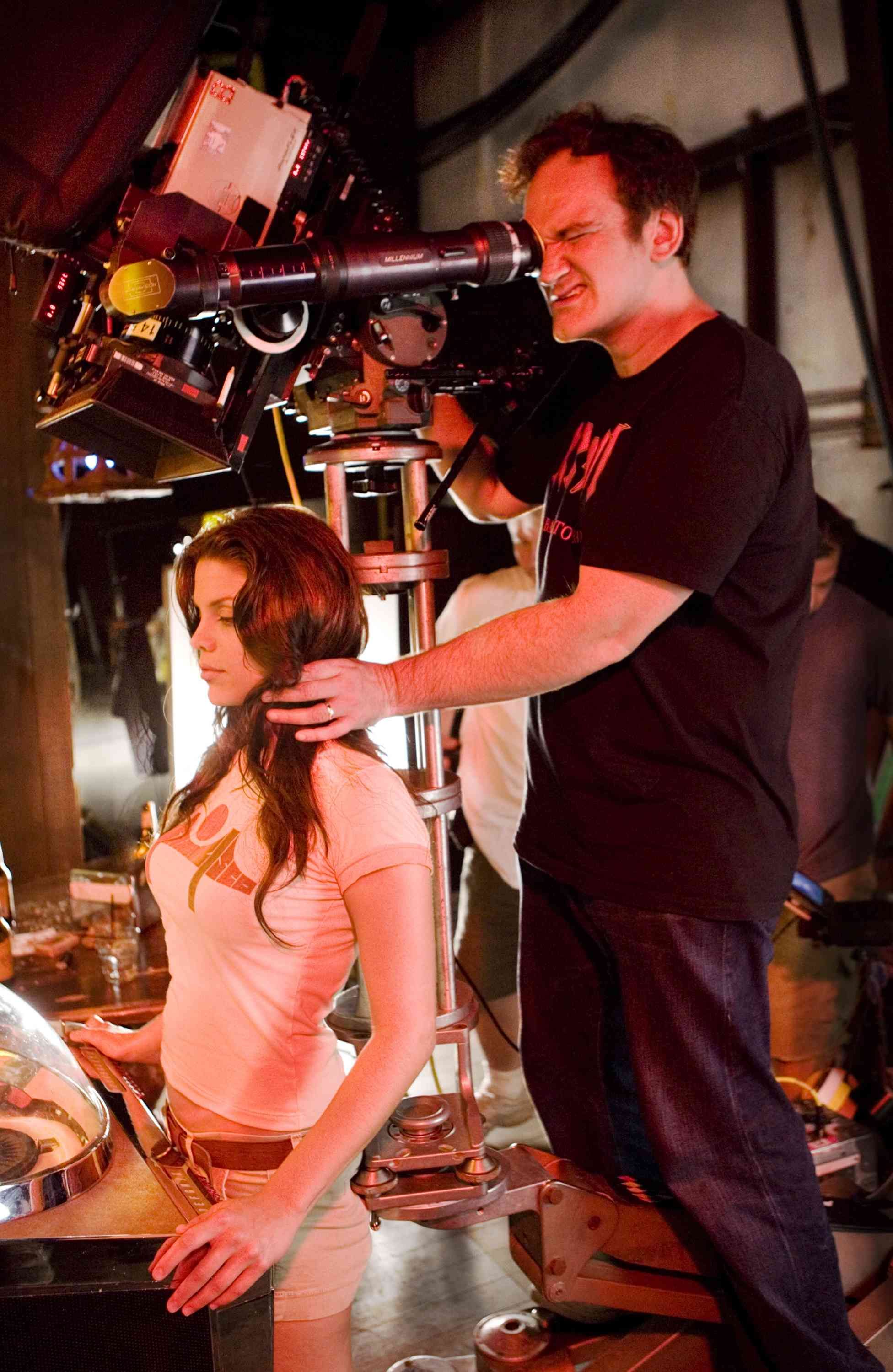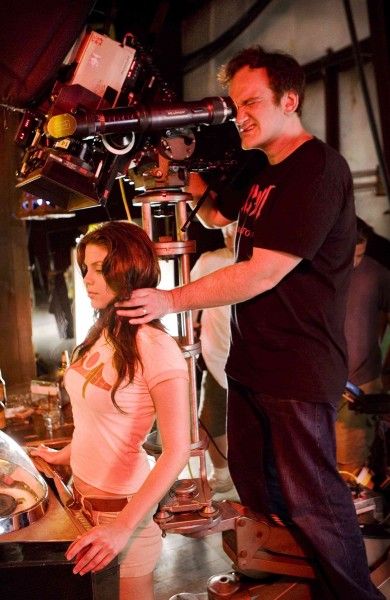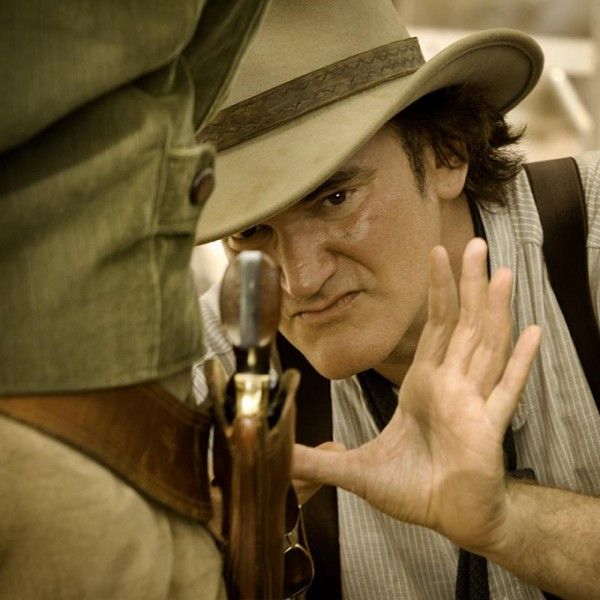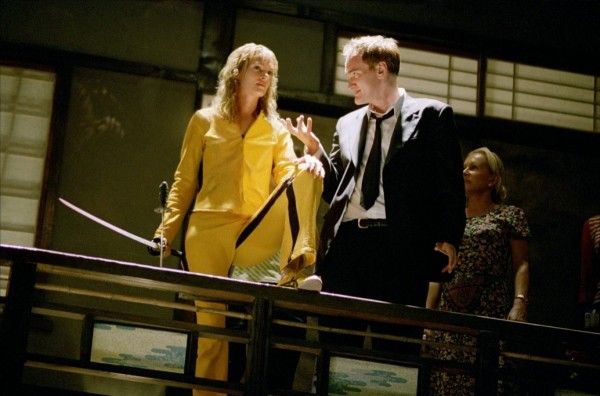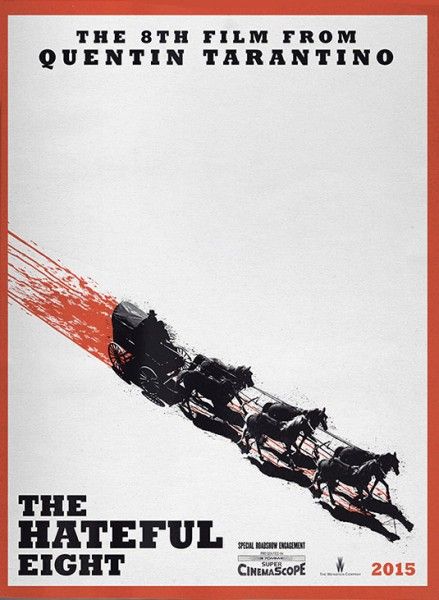Quentin Tarantino is retiring. Some version of this phrase has been reported for the past few years as one of our great filmmakers began touting his plans to stop making movies before he started making bad ones, and now he’s set a definitive end date for his career: 10 movies. While selling his next film, the Western The Hateful Eight, to international buyers at AFM recently, Tarantino announced that he absolutely plans to retire from filmmaking after his tenth film, saying he’s got “two more to go after this,” which seems to indicate that he’s counting Kill Bill as one film.
But he’s got plenty to do before he recedes to a life of writing and reading, as he also spoke about the surprising sources of inspiration for The Hateful Eight (spoiler alert: they’re TV shows) and expanded upon his plans to release the film in 70mm, as it is poised to be "the biggest wide screen movie shot in the last 40 years". Much more after the jump.
In a rundown of Tarantino’s AFM appearance over at Deadline, a transcription of the filmmaker’s comments regarding retirement were provided, in which he gives himself a little wiggle room to return:
“I don’t believe you should stay on stage until people are begging you to get off. I like the idea of leaving them wanting a bit more. I do think directing is a young man’s game and I like the idea of an umbilical cord connection from my first to my last movie. I’m not trying to ridicule anyone who thinks differently, but I want to go out while I’m still hard…I like that I will leave a ten-film filmography, and so I’ve got two more to go after this. It’s not etched in stone, but that is the plan. If I get to the tenth, do a good job and don’t screw it up, well that sounds like a good way to end the old career. If, later on, I come across a good movie, I won’t not do it just because I said I wouldn’t. But ten and done, leaving them wanting more, that sounds right.”
Kurt Russell followed up by saying, “You don’t actually believe this shit do you?” while Samuel L. Jackson added, “What’s Quentin going to do with himself if he’s not doing this?” But the director replied that he's serious about his intentions. Tarantino has spoken at length about his plans for retirement in the past, citing his desire to ensure that his filmography is pristine. Indeed, there’s no such thing as a “bad” Quentin Tarantino film, and while I’ll certainly be sad if he only makes three more movies, I can certainly respect his decision.
With regards to The Hateful Eight, though, the full cast was recently set, and some members were in attendance at AFM to help find the right international buyers for the Western. Speaking about his filmic inspirations for telling a story about a group of outlaws who are forced to hole up together during a snowstorm, Tarantino cited some surprising examples given his disdain for all things video/digital:
“It’s less inspired by one Western movie than by Bonanza, The Virginians, High Chaparral,” Tarantino said. “Twice per season, those shows would have an episode where a bunch of outlaws would take the lead characters hostage. They would come to the Ponderosa and hold everybody hostage, or to go Judge Garth’s place–Lee J. Cobb played him–in The Virginians, and take hostages. There would be a guest star like David Carradine, Darren McGavin, Claude Akins, Robert Culp, Charles Bronson or James Coburn. I don’t like that storyline in a modern context, but I love it in a Western where you would pass halfway through the show to find out if they were good or bad guys, and they all had a past that was revealed. “I thought, what if I did a movie starring nothing but those characters? No heroes, no Michael Landons. Just a bunch of nefarious guys in a room, all telling back stories that may or may not be true. Trap those guys together in a room with a blizzard outside, give them guns, and see what happens.”
Tarantino being Tarantino, he also took the opportunity to make some digs at digital, saying he wanted to find a way to put film back into the conversation:
“I thought, how can I make them show [the beauty of] film? Well, I can shoot in 70 mm and leave them asking, what’s the point of showing it any other way? I had a plan and asked the Weinsteins to tell me how it could be realized. Now that film has become endangered, and the theatrical experience is becoming more and more a throwaway, what we could do was go back to the 60s style, when there were big road show productions of big films like The Sand Pebbles, Mutiny On The County, Battle Of The Bulge, or It’s A Mad, Mad Mad Mad World. There would be an exclusive engagement in 70 mm in a big theater or opera house that would play for a month. It felt like a night at the theater or the symphony. Then they would cut it down and it would show up at the theaters and the drive ins, near you.”
It sounds like Tarantino will be taking a similar route to Christopher Nolan’s release plans for Interstellar, which saw 70mm and 35mm showings starting days before the digital rollout. The filmmaker said he and cinematographer Bob Richardson have been working closely with Panavision to ensure that The Hateful Eight will be very, very big:
“Panavision is not only behind this movie, they look at it as a legacy. They are inventing a lot of the stuff we need, and this is being supervised by my three-time Oscar winning cinematographer Bob Richardson, who’s back with me and after Kill Bill, Inglourious Basterds and Django Unchained. I couldn’t do this if he wasn’t in my corner. He went to Panavision to check out lenses for this big Sherman Tank of a camera he’ll use. He goes into the warehouse room and sees all these big crazy lenses. He asks, what are those? It was the ultra-Panavision lenses that haven’t been used since How The West Was Won, Mutiny on the Bounty, Battle Of The Bulge and It’s A Mad Mad Mad Mad World, which were all bigger than the normal 70 mm.
Tarantino expanded upon the technical aspects of the Hateful Eight shoot, saying they're shooting with lenses that haven't been used for years:
If the normal scope is 235, this is 278, the widest frame possible on film. The projectors need a decoder, an adapter, to blow it out that way. That’s why Mad Mad World, Battle Of The Bulge and Ice Station Zebra look the way they do. The last movie to use these lenses was Khartoum with Charlton Heston and Laurence Olivier. We’re using those lenses for this movie. We’ve been testing them the last month and everything is A-ok. They look amazing. We are literally coming out with the biggest wide screen movie shot in the last 40 years.”
This is all incredibly exciting stuff, and my hope is that at least some of the theaters that installed film projectors for Nolan’s Interstellar will leave them in place for The Hateful Eight, which is set to be released later next year. But ultimately, I'm not very optimistic. Theater owners have shown a complete disinterest in sticking with film projection even with objections from filmmakers like Nolan and Steven Spielberg, and now that nearly all movies are shot digitally, it makes financial sense for theaters to simply project everything on digital as well. The Hateful Eight's release is still a year away so I'll be very curious to see how the exhibitors handle its distribution.

